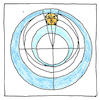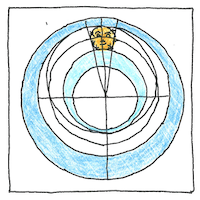Claudius Ptolemy
astronomy

|
Geocentrism
Claudius Ptolemaeus of Alexandria wrote the definitive texts on astronomy and astrology in the second century. In the Almagest, Ptolemy described the obliquity of the ecliptic, shadows of gnomon at equinoxes and solstices, precession of the equinoxes, lunar parallax and apogee, solar and lunar eclipses, and retrograde motions of the planets. Ptolemy explained how the apparent motions of the stars, sun, moon, and the five planets, were described mathematically by a set of perfect spheres. Each planet circles in an epicycle. Each epicycle circles in a deferent. The center of all nested deferents is a point halfway between the stationary earth and the equant point. Ptolemy claimed that his celestial spheres were actually installed in the heavens— concentric transparent crystalline spheres spinning around above us.
Ptolemys
Ptolemy, Ptolemy, not those Ptolemys. The other Ptolemys were pharaohs of Egypt starting with a fellow from Alexander’s army who made himself pharaoh in 323 BCE. Our Ptolemy died around AD 168 and was not a pharaoh. Ours wrote a book on astronomy and one on geography. Wrote a book on astrology to match the one on astronomy. He wrote a book on harmonics and another on optics. All Ptolemys.
Disorder
It would be nice if everything were somehow in control; however, total control would tend to stifle rock and roll.



Ptolemy, like Aristotle, deduced natural science from first principles. All orbits were circular because the circle is the most perfect geometric figure. Unlike Aristotle, Ptolemy tried to adjust the model to fit the observations.
See also in The book of science:
Readings in wikipedia: